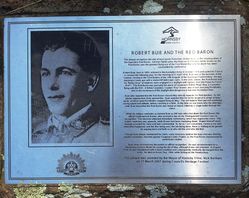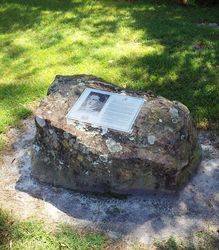
Gunner Robert Buie & the "Red Baron"Print Page 
The plaque commemorates Robert Buie, a Brooklyn oyster farmer who claimed to have shot down Baron Mannheim von Richthofen, the German pilot, known as the "Red Baron" during World War One.
The plaque contains a photographic image of Gunner Buie and inscription concerning his part in the shooting down of Baron Mannheim von Richthofen.
Location
| Address: | Brooklyn Road, Brooklyn Park, Brooklyn, 2083 |
|---|---|
| State: | NSW |
| Area: | AUS |
| GPS Coordinates: | Lat: -33.547778 Long: 151.211389 Note: GPS Coordinates are approximate. |
Details
| Monument Type: | Plaque |
|---|---|
| Monument Theme: | People |
| Sub-Theme: | Military |
| Link: | http://www.warmemorialsregister.nsw… |
Dedication
| Actual Monument Dedication Date: | Saturday 17th March, 2007 |
|---|
Robert Buie and the Red Baron
This plaque recognises the role of local oyster fisherman, Robert Buie, in the shooting down of the legendary Red Baron. German fighter pilot, Manfred von Richthofen, better known as the Red Baron, was the greatest flying ace of the First World War and his death has been surrounded by controversy.
Robert Buie, born in 1893, enlisted in the Australian Army in October 1916 and sailed fro France in January of the following year. On the morning of the 21st April 1918, Buie was in the trenches of the Somme, serving in the 53rd Battery of the 14th Brigade of the Australian Field Artillery. He was manning a Lewis gun with a makeshift telescopic sight. In the skies above, the Red baron and his “flying circus” of triplanes were engaged in a dogfight with fighters from the Royal Air Force (RAF). The Red baron was pursuing the plane of Lieutenant Wilfrid “Wop” May, a Canadian flying with the RAF. A fellow Canadian, Captain “Roy” Brown, was in turn pursuing Richthofen, who in the excitement of the dogfight flew dangerously low over Australian lines. Buie later reported that the Red Baron chased May directly towards his field position. As the planes approached, Buie opened fire. Buie reported that he hit his target at a range of forty yards, at which point Richthofen stopped firing on May. The red triplane then passed overhead, losing speed and altitude, before crashing in a field. At the time no one knew who the pilot was. Later Buie heard that the Red Baron was found on board, killed by a single bullet through the chest.
While his military comrades acclaimed Buie as the man who shot down the Red Baron, the official credit went to Brown, who received a bar on his Distinguished Service Cross in recognition. This decision attracted immediate controversy, which has raged ever since. The bullet’s trajectory was upwards, while Brown had been swooping down. Brown himself never strongly asserted his claim and later commented, ‘As far as I am concerned, I know in my own mind what happened, and the War being over, the job being done, there is nothing to be gained by arguing back and forth as to who did this and who did that’. Though Buie always maintained his claim, some historians believe the fatal shot was fired by another Australian, machine-gunner Sergeant Cedric Popkin, as the Red Baron manoeuvred to avoid Buie’s bullets. Buie never received any decoration or official recognition. He was recommended for a Meritorious Service Medal for saving the life of May, although it was not awarded. In August 1918, he was hospitalised with a heart condition and subsequently discharged from the army. He died on ANZAC Day, 1964, while fishing on the Hawkesbury.
This plaque was unveiled by the Mayor of Hornsby Shire, Nick Berman, on 17 March 2007 during Council's Heritage Festival.





